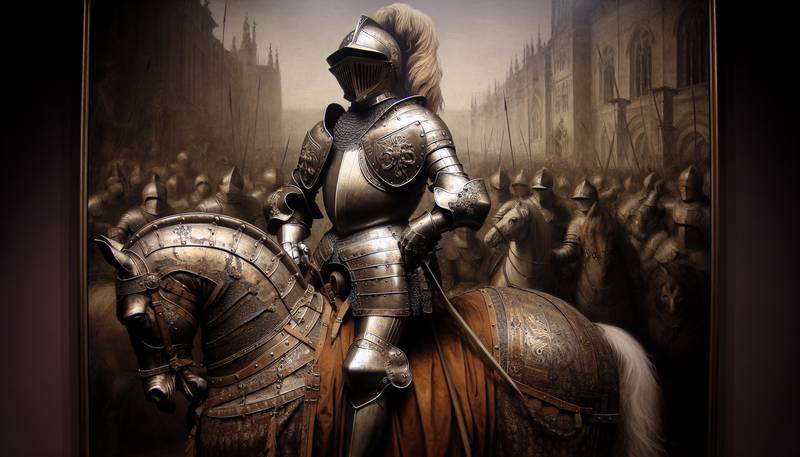Medieval Armor to Courtly Attire: Europe's Knightly Fashion

A Brief History of Medieval ArmorOnce upon a time in medieval Europe, knights rode gallantly on their noble steeds, donning magnificent and protective armor, ready to engage in battle and protect their honor. This armor, forged by skilled blacksmiths, was not just for show. It was designed to withstand the brutalities of war and the perils of jousting tournaments.
The art of armoring reached its peak during the 15th and 16th centuries. Knights wore full plate armor that covered their entire bodies. This included a helmet, breastplate, backplate, gauntlets, leg and arm guards, and a stunning array of pointy, shiny bits to intimidate foes and impress damsels.
Of course, as with all great fashions, armor evolved over time. Here's a quick rundown of medieval armor's greatest hits:
- Chainmail: The go-to choice for the fashion-conscious knight of the early medieval period. Made from interlocking rings of metal, it allowed for some freedom of movement while providing a fair amount of protection. Not great against arrows, though!
- Coat of plates: A popular option for knights on a budget. This armor, popular in the 13th and 14th centuries, consisted of a series of metal plates riveted or sewn onto a fabric garment. Not as flashy as full plate, but it got the job done.
- Full plate armor: The gold standard of medieval armor, this ensemble covered the knight from head to toe in metal plates, providing the ultimate in protection and dashing good looks.
From the Battlefield to the Banquet Hall: Courtly AttireNow, as we all know, a knight can't spend all his time on the battlefield or jousting field. Occasionally, he must attend to matters of state, mingle with nobles, and perhaps even engage in a bit of courtly romance. Thankfully, medieval Europe had plenty of fancy duds for these occasions as well.
Courtly attire for knights and noblemen typically included a doublet, hose, and a cape or cloak. Doublets were snug-fitting garments worn over a shirt, often with decorative slashes or puffs to showcase the fine fabric underneath. Hose were essentially leggings, although they were not quite as stretchy or forgiving as our modern-day yoga pants.
Cloaks, meanwhile, were a must-have for any self-respecting knight. Not only did they keep you warm in drafty castles, but they also added a touch of flair to any outfit. A knight could make quite an entrance, sweeping into a room with his cloak billowing dramatically behind him.Accessories: The Finishing TouchesNo knightly ensemble would be complete without a few well-chosen accessories. Belts were a practical and fashionable choice, used to cinch in those doublets and provide a handy place to hang one's sword. Knights also sported decorative pins and brooches, often featuring their heraldic symbols or other emblems of chivalry.
Let's not forget about footwear! Knights wore a variety of shoes and boots, both for battle and for more genteel occasions. On the battlefield, sabatons (metal shoe covers) were often worn over boots for added protection. In the court, knights might opt for more stylish footwear, such as pointed-toe shoes or soft leather boots.
Finally, we come to the pièce de résistance: the hat. Medieval Europe was positively mad for hats, and knights were no exception. Whether it was a tall, conical cap, a jaunty beret, or a wide-brimmed chaperon, a well-chosen hat could really tie a knight's outfit together.Fashion Faux Pas: What Not to WearOf course, even the most fashionable of knights could occasionally make a sartorial misstep. Here are a few things to avoid when dressing for success in the medieval world:
- Sumptuary laws: These regulations dictated what certain classes of people could and could not wear. Wearing the wrong color or fabric could land a knight in some serious hot water!
- Overdoing it: While knights certainly enjoyed showing off their wealth and status, there was such a thing as too much bling. Remember, a knight's primary function was to serve and protect, not to outshine the king in the fashion department.
- Ignoring practicality: As tempting as it might be to don the most elaborate and outlandish outfit, knights still had to be able to move and fight when necessary. Choosing fashion over function could have disastrous consequences!
Medieval Armor and Courtly Attire: A Lasting LegacyWhile we may not see many knights swaggering about in shining armor or swishing their cloaks these days, the influence of medieval fashion can still be seen in modern times. From the continued popularity of chainmail jewelry to the enduring appeal of high-quality leather boots, the spirit of Europe's knightly fashion lives on.
So, next time you're suiting up for battle (or just dressing up for a fancy event), take a moment to remember the knights of yore and their impeccable fashion sense. Truly, they were the embodiment of style and chivalry.
|
|








